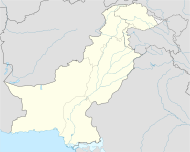Data Darbar
| Data Darbar | |
|---|---|
داتا دربار | |
Sufi Islam | |
| Province | Punjab |
| Location | |
| Location | Lahore |
| Country | Pakistan |
| Geographic coordinates | 31°34′44″N 74°18′17″E / 31.57898°N 74.30474°E |
| Architecture | |
| Type | Mosque and Sufi mausoleum |
| Style | Modern |
| Specifications | |
| Dome(s) | 1 |
| Minaret(s) | 4 |
Data Darbar (
The site is considered to be the most sacred place in Lahore,[2] and attracts up to one million visitors to its annual urs festival.[1]
Location
Data Darbar is located in the centre of Old City Lahore. Surrounding it are Lower Mall Road, Bhati Gate, Gawalmandi & Karbala Gamay Shah.
History
The shrine was originally established as a simple grave next to the mosque which Ali Hujwiri had built on the outskirts of Lahore in the 11th century. The shrine came under Pakistani government control as part of the Auquf Ordinance of 1960, with the official aim of preventing shrine caretakers throughout the country from financially exploiting devotees.
Since 1965, the mehfil-e-sama, a 2-day qawwali music festival, had been held adjacent to the shrine, which in 1992 shifted to a nearby school.[4]
On 1 July 2010, two suicide bombers attacked the shrine. At least 50 people were killed, and 200 others were hurt in the blasts.[5][6][7] On 8 May 2019, another blast at the same site killed twelve people included police officials Saddam Hussain, Head Constable Shahid Nazir, Head Constable Muhammad Sohail, Head Constable Gulzar Ahmad, Constable Muhammad Saleem, and security guard Rafaqat Ali near the entrance gate for female visitors.[8]
The shrine of Hujwiri is housed in a Mughal era tomb crafted of carved white marble. The tomb is surrounded by a massive marble courtyard, while a new educational institution at the shrine complex utilizes modernist architecture.[9]
The site is considered to be the most sacred place in Lahore.[2] The shrine has emerged a major economic, political, and social centre in Lahore,[1] and is one of the only places in Lahore where the extremely rich and extremely poor share space together.[1]
It is widely believed among devotees that the saint interred at the shrine is the supreme authority over all Sufi saints in the Indian subcontinent, and that no new Sufi saint could immigrate to the subcontinent without obtaining permission from the spirit of Hujwiri.[9]
Following the establishment of a shrine dedicated to Hujwiri, his tomb was visited by Terror attacks
Architecture

Significance
Hujwiri's teachings were critical of practices associated with South Asian Islam, such as the use of drugs, and dancing.[1] He also taught that Sufi saints were themselves still obliged to the demands of Islam, and so is revered by reformist Muslims who are critical of Sufi practice, as well as traditionalist Muslims who revere Sufi shrines.[1]
Social services
The shrine provides a wide array of social services which have made it a popular hub for impoverished residents.[1] In a custom that is 1,000 years old,[2] up to 50,000 visitors per day are offered free food at the shrine.[2] Patrons facing personal difficulties frequently donate money or labour to the shrine's free-kitchen fund,[2] in line with Islam's emphasis on feeding the poor.[2] The shrine also provides for students' education in nearby schools, and helps fund local hospitals as part of its social mission.[2]
Access
The shrine remains open at all hours, and welcomes visitors who freely enter the complex. The shrine is visited by approximately 30,000 to 60,000 visitors on a daily basis,[1] though the number can double on religious holidays, and on Thursdays[1] - the traditional night for visiting shrines. Approximately 1,000,000 devotees visit the shrine during its annual urs festival.[1]
The shrine is served by the Bhatti Chowk station of the Lahore Metrobus.
Administration
The shrine is managed as part of an Auqaf foundation as part of the Auqaf Ordinance of 1960.[1] The shrine is managed by approximately 200 full-time workers,[1] excluding security services.[1] The shrine produces the most revenue for the Auqaf board out of all the some 400 shrines under its control in Punjab province,[1] and contributes approximately 33% of the board's revenue.[1] The shrine collects 4 times more income than is spent on the shrine's upkeep.[1] Considered to be the centre of all shrines in Punjab, religious practices and sermons are subject to more government regulation than at other shrines in Pakistan.[1]
Gallery
-
The shrine surrounds the green-domed tomb
-
Ali Hajveri Tomb at night
-
Data Darbar Mosque
-
The shine's interior is decorated with mirror work and flowers
-
The cenotaph is surrounded by carved marble screens
-
View of the new mosque's interior
-
Supplicants at the innermost sanctum of the shrine
-
Entrance to the shrine's inner sanctum
-
An evening view of the shrine and its adjacent mosque
-
The shrine is fronted by a large courtyard for devotees to gather every Thursday night, as well as on other festival nights.
See also
References
- ^ ISBN 9781317435969. Retrieved 12 September 2017.
- ^ ISBN 9781317647454. Retrieved 12 September 2017.
- ISBN 9780520046603. Retrieved 29 August 2017.
- ISBN 9780824049461. Retrieved 12 September 2017.
- ^ "Explosions at famous shrine in Pakistan kill dozens". CNN. 2 July 2010. Retrieved 3 July 2010.
- ^ "Deadly blasts hit Sufi shrine in Lahore". BBC. 1 July 2010. Retrieved 1 July 2010.
- ^ Tavernise, Sabrina (1 July 2010). "Blasts at Sufi Shrine in Pakistan Kill at Least 35". The New York Times. Retrieved 1 July 2010.
- ^ "8 Dead In Blast Near Sufi Shrine In Lahore; We Were Targets, Says Police". NDTV.com. Retrieved 8 May 2019.
- ^ ISBN 9780873658591. Retrieved 12 September 2017.














